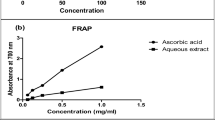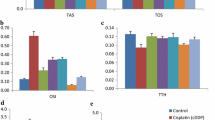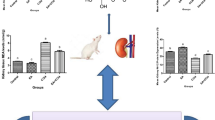Abstract
Trichloroethylene (TCE), a nephrotoxicant is known to cause severe damage to the kidney. In this study, the nephroprotective potential of hesperidin was evaluated against TCE-induced nephrotoxicity in wistar rats. Oral administration of TCE (1000 mg/kg b.wt) for 15 days enhanced renal lipid peroxidation and reduced antioxidant enzymes armoury viz., reduced renal glutathione, glutathione peroxidase, glutathione reductase, glutathione-S-transferase, catalase and superoxide dismutase. It also enhanced the levels of blood urea nitrogen, creatinine and kidney injury molecule (KIM-1). Caspase-3 and bax expression were found to be elevated, while that of bcl-2 reduced suggesting that TCE induces apoptosis. However, pretreatment with hesperidin at a dose of 100 and 200 mg/kg b.wt for 15 days significantly decreased lipid peroxidation, increased the levels of antioxidant enzymes and reduced blood urea, creatinine and KIM-1 levels. Hesperidin also modulated the apoptotic pathways by altering the expressions of caspase-3, bax and bcl-2 to normal. Our results suggest that hesperidin can be used as a nephroprotective agent against TCE-induced nephrotoxicity.
Graphical Abstract









Similar content being viewed by others
Abbreviations
- TCE:
-
1,1,2-Trichloroethylene
- DCVG:
-
S-(1,2-dichlorovinyl)-l-glutathione
- DCVC:
-
S-(1,2-dichlorovinyl)-l-cysteine
- GPx:
-
Glutathione peroxidase
- GSH:
-
Glutathione
- GR:
-
Glutathione reductase
- GST:
-
Glutathione-S-transferase
- LPO:
-
Lipid peroxidation
- MDA:
-
Malondialdehyde
- PMS:
-
Post-mitochondrial supernatant
- SOD:
-
Superoxide dismutase
- BUN:
-
Blood urea nitrogen
- KIM-1:
-
Kidney injury molecule
- HS:
-
Hesperidin
- ROS:
-
Reactive oxygen species
References
Chiu WA, Jinot J, Scott CS, Makris SL, Cooper GS, Dzubow RC, Bale AS, Evans MV, Guyton KZ, Keshava N, Lipscomb JC, Barone S Jr, Fox JF, Gwinn MR, Schaum J, Caldwell JC (2013) Human health effects of trichloroethylene: key findings and scientific issues. Environ Health Perspect 121:303–311
Lash LH, Qian W, Putt DA, Hueni SE, Elfarra AA, Krause RJ, Parker JC (2001) Renal and hepatic toxicity of trichloroethylene and its glutathione-derived metabolites in rats and mice: sex-, species-, and tissue-dependent differences. Pharmacol Exp Ther 297:155–164
NRC (National Research Council) (2006) Assessing the human health risks of trichloroethylene: key scientific issues. The National Academies Press, Washington, DC
Zhao Y, Krishnadasan A, Kennedy N, Morgenstern H, Ritz B (2005) Estimated effects of solvents and mineral oils on cancer incidence and mortality in a cohort of aerospace workers. Am J Ind Med 48:249–258
Charbotel B, Fevotte J, Hours M, Martin JL, Bergeret A (2006) Case-control study on renal cell cancer and occupational exposure to trichloroethylene. Part II: epidemiological aspects. Ann Occup Hyg 50:777–787
Moore L, Boffetta P, Karami S, Brennan P, Stewart P, Hung R, Zaridze D, Matveev V, Janout V, Kollarova H, Bencko V, Navratilova M, Szeszenia-Dabrowska N, Mates D, Gromiec J, Holcatova I, Merino M, Chanock S, Chow W, Rothman N (2010) Occupational trichloroethylene exposure and renal carcinoma risk: evidence of genetic susceptibility by reductive metabolism gene variants. Cancer Res 70:6527–6536
Lock EJ, Reed CJ (2006) Trichloroethylene: mechanisms of renal toxicity and renal cancer and relevance to risk assessment. Toxicol Sci 91:313–331
Lock EA (2010) Renal xenobiotic metabolism. In: McQueen CA (ed) Comprehensive toxicolology. Elsevier, Liverpool, pp 55–79
Lash LH, Fisher JW, Lipscomb JC, Parker JC (2000) Metabolism of trichloroethylene. Environ Health Perspect 108:177–200
Liu RH (2004) Potential synergy of phytochemicals in cancer prevention: mechanism of action. J Nutr 134:3479–3485
Mates JM, Segura JA, Alonso FJ, Márquez J (2011) Anticancer antioxidant regulatory functions of phytochemicals. Curr Med Chem 18:2315–2338
Fu Z, Zhen W, Yuskavage J, Liu D (2011) Epigallocatechin gallate delays the onset of type 1 diabetes in spontaneous non-obese diabetic mice. Br J Nutr 105:1218–1225
Hail N Jr, Cortes M, Drake E, Spallholz J (2008) Cancer chemoprevention: a radical perspective. Free Radic Biol Med 45:97–110
Tan AC, Konczak I, Sze DM, Ramzan I (2011) Molecular pathways for cancer chemoprevention by dietary phytochemicals. Nutr Cancer 63:495–505
Assini JM, Mulvihill EE, Huff MW (2013) Citrus flavonoids and lipid metabolism. Curr Opin Lipidol 24:34–40
Izzi V, Masuelli L, Tresoldi I, Sacchetti P, Modesti A, Galvano F, Bei R (2012) The effects of dietary flavonoids on the regulation of redox inflammatory networks. Front Biosci 17:2396–2418
Kay CD, Hooper L, Kroon PA, Rimm EB, Cassidy A (2012) Relative impact of flavonoid composition, dose and structure on vascular function: a systematic review of randomized controlled trials of flavonoid-rich food products. Mol Nutr Food Res 56:1605–1616
Clere N, Faure S, Martinez MC, Andriantsitohaina R (2011) Anticancer properties of flavonoids: roles in various stages of carcinogenesis. Cardiovasc Hematol Agents Med Chem 9:62–77
Wilmsen PK, Spada DS, Salvador M (2005) Antioxidant activity of the flavonoid hesperidin in chemical and biological systems. J Agric Food Chem 53:4757–4761
Berkarda B, Koyuncu H, Soybir G, Baykut F (1998) Inhibitory effect of hesperidin on tumour initiation and promotion in mouse skin. Res Exp Med (Berl) 198:93–99
Lee CJ, Wilson L, Jordan MA, Nguyen V, Tang J, Smiyun G (2010) Hesperidin suppressed proliferations of both human breast cancer and androgen-dependent prostate cancer cells. Phytother Res 24:S15–S19
Kamaraj S, Anandakumar P, Jagan S, Ramakrishnan G, Devaki T (2011) Hesperidin attenuates mitochondrial dysfunction during benzo(a)pyrene-induced lung carcinogenesis in mice. Fundam Clin Pharmacol 25:91–98
Saiprasad G, Chitra P, Manikandan R, Sudhandiran G (2013) Hesperidin alleviates oxidative stress and downregulates the expressions of proliferative and inflammatory markers in azoxymethane-induced experimental coloncarcinogenesis in mice. Inflamm Res 62:425–440
Kaur G, Tirkey N, Chopra K (2006) Beneficial effect of hesperidin on lipopolysaccharide-induced hepatotoxicity. Toxicology 226:152–160
Anandan R, Subramanian P (2012) Renal protective effect of hesperidin on gentamicin-induced acute nephrotoxicity in male Wistar albino rats. Redox Rep 17:219–226
Sahu BD, Kuncha M, Sindhura GJ, Sistla R (2013) Hesperidin attenuates cisplatin-induced acute renal injury by decreasing oxidative stress, inflammation and DNA damage. Phytomedicine 20:453–460
Khan S, Priyamvada S, Khan SA, Khan W, Farooq N, Khan F, Yusufi AN (2009) Effect of trichloroethylene (TCE) toxicity on the enzymes of carbohydrate metabolism, brush border membrane and oxidative stress in kidney and other rat tissues. Food Chem Toxicol 47:1562–1568
Ahmad ST, Sultana S (2011) Tannic acid mitigates cisplatin-induced nephrotoxicity in mice. Hum Exp Toxicol 31:145–156
Wright JR, Colby HD, Miles PR (1981) Cytosolic factors which affect microsomal lipid peroxidation in lung and liver. Arch Biochem Biophys 206:296–304
Jollow DJ, Mitchell JR, Zampaglione N, Gillete JR (1974) Bromobenzene-induced liver necrosis. Protective role of glutathione and evidence for 3,4-bromobenzene oxide as the hepatotoxic metabolite. Pharmacology 11:151–169
Mohandas J, Marshall JJ, Duggin GG, Horvath JS, Tiller DJ (1984) Differential distribution of glutathione and glutathione-related enzymes in rabbit kidney: possible implications in analgesic nephropathy. Biochem Pharmacol 33:1801–1807
Carlberg I, Mannervik B (1975) Glutathione reductase levels in rat brain. J Biol Chem 250:5475–5479
Claiborne A (1985) Catalase activity. In: Greenwald RA (ed) CRC handbook of methods in oxygen radical research. CRC, Boca Raton, pp 283–284
Marklund S, Marklund G (1974) Involvement of the superoxide anion radical in the autoxidation of pyrogallol and a convenient assay for superoxide dismutase. Eur J Biochem 47:469–474
Habig WH, Pabst MJ, Jakoby WB (1974) Glutathione S-transferases. J Biol Chem 249:7130–7139
Kanter M (1975) Clinical chemistry. The Bobber Merrill Company Inc, Indianapolis
Hare RS (1950) Endogenous creatinine in serum and urine. Proc Soc Exp Biol Med 74:148–151
Lowry OH, Rosebrough NJ, Farr AL, Randall RJL (1951) Protein measurement with the Folin phenol reagent. J Biol Chem 193:265–275
Cojocel C, Beuter W, Müller W, Mayer D (1989) Lipid peroxidation: a possible mechanism of trichloroethylene-induced nephrotoxicity. Toxicology 55:131–141
McGoldrick TA, Lock EA, Rodilla V, Hawksworth GM (2003) Renal cysteine conjugate C-S lyase mediated toxicity of halogenated alkenes in primary cultures of human and rat proximal tubule cells. Arch Toxicol 77:365–370
Vaidya VS, Shankar L, Lock EA, Bucci TJ, Mehendale HM (2003) Renal injury and repair following S-1,2-dichlorovinyl-l-cysteine administration to mice. Toxicol Appl Pharmacol 188:110–121
Tripoli E, Guardia ML, Giammanco S, Majo DD, Giammanco M (2007) Citrus flavonoids: molecular structure, biological activity and nutritional properties: a review. Food Chem 104:466–479
Williams RJ, Spencer JPE, Rice-Evans C (2004) Serial review: flavonoids and isoflavonones (Phytoestrogens): absorption, metabolism and bioactivity. Free Radic Biol Med 36:838–849
Cushnie TPT, Lamb AJ (2005) Antimicrobial activity of flavonoids. Int J Antimicrob Agents 26:343–356
Sharififar F, Dehghn-Nudeh G, Mirtajaldini M (2009) Major flavonoids with antioxidant activity from Teucrium polium. Food Chem 112:885–888
Pal RS, Ariharasivakumar G, Girhepunjhe K, Upadhay A (2009) In-vitro antioxidative activity of phenolic and flavonoids compounds extracted from seeds of Abrus precatorius. Int J Pharm Sci 1:136–140
Garg A, Garg S, Zaneveld LJD, Singla AK (2001) Chemistry and pharmacology of the citrus bioflavonoid hesperidin. Phytother Res 15:655–669
Tanaka T, Tanaka T, Tanaka M, Kuno T (2012) Cancer chemoprevention by citrus pulp and juices containing high amounts of β-cryptoxanthin and hesperidin. J Biomed Biotechnol 2012:1–10
Kohen R, Nyska A (2002) Oxidation of biological systems: oxidative stress phenomena, antioxidants, redox reactions, and methods for their quantification. Toxicol Pathol 30:620–630
Marnett LJ (1999) Lipid peroxidation-DNA damage by malondialdehyde. Mutat Res 424:83–95
Kunwar A, Priyadarsini KI (2011) Free radicals, oxidative stress and importance of antioxidants in human health. J Med Allied Sci 1:53–60
Torasson M, Clark J, Dankovic D, Mathias P, Skaggs S, Walker C, Werren D (1999) Oxidativestress and DNA damage in Fisher rats following acute exposure to trichloroethylene or perchloroethylene. Toxicology 138:43–53
Tabrez S, Ahmad M (2011) Some enzymatic/nonenzymatic antioxidants as potential stress biomarkers of trichloroethylene, heavy metal mixture, and ethyl alcohol in rat tissues. Environ Toxicol 26:207–216
Pompella A, Visvikis A, Paolicchi A, De Tata V, Casini AF (2003) The changing faces of glutathione, a cellular protagonist. Biochem Pharmacol 66:1499–1503
Ahmadi A, Hosseinimehr SJ, Naghshvar F, Hajir E, Ghahremani M (2008) Chemoprotective effects of hesperidin against genotoxicity induced by cyclophosphamide in mice bone marrow cells. Arch Pharmacol Res 31:794–797
Abdel-Raheem IT, Abdel-Ghany AA (2009) Hesperidin alleviates doxorubicin-induced cardiotoxicity in rats. J Egypt Natl Cancer Inst 21:175
Pires Das Neves RN, Carvalho F, Carvalho M, Fernandes E, Soares E, Bas-tos MDL, Pereira MDL (2004) Protective activity of hesperidin and lipoic acid against sodium arsenite acute toxicity in mice. Toxicol Pathol 32:527–535
Ibrahim SS (2008) Protective effect of hesperidin, a citrus bioflavonoid, on 693 diabetes-induced brain damage in rats. J Appl Sci Res 4:84–95
Tirkey N, Pilkhwal S, Kuhad A, Chopra K (2005) Hesperidin, a citrus bioflavonoid, decreases the oxidative stress produced by carbon tetrachloride in rat liver and kidney. BMC Pharmacol 5:2
Gharib OA, Gharib MA (2008) Kombucha tea ameliorates trichloroethylene induced hepatic damages in rats via inhibition of oxidative stress and free radicals induction. Egypt J Sci Appl 21:481–498
Bonventre JV (2009) Kidney injury molecule-1 (KIM-1): a urinary biomarker and much more. Nephrol Dial Transpl 24:3265–3268
Bonventre JV, Yang L (2010) Kidney injury molecule-1. Curr Opin Crit Care 16:556–561
Pop C, Salvesen GS (2009) Human caspases: activation, specificity, and regulation. J Biol Chem 284:21777–21781
Porter AG (2006) Flipping the safety catch of procaspase-3. Nat Chem Biol 2:509–510
Xu F, Papanayotou I, Putt DA, Wang J, Lash LH (2008) Role of mitochondrial dysfunction in cellular responses to S-(1,2-dichlorovinyl)-l-cysteine in primary cultures of human proximal tubular cells. Biochem Pharmacol 76:552–567
Hacker G, Weber A (2007) BH3-only proteins trigger cytochrome c release, but how? Arch Biochem Biophys 462:150–155
Carthy CM, Yanagawa B, Luo H, Granville DJ, Yang D, Cheung P, Cheung C, Esfandiarei M, Rudin CM, Thompson CB, Hunt DWC, McManus BM (2003) Bcl-2 and Bcl-xL overexpression inhibits cytochrome c release, activation of multiple caspases, and virus release following coxsackievirus B3 infection. Virology 313:147–157
Lalier L, Cartron PF, Juin P, Nedelkina S, Manon S, Bechinger B, Vallette FM (2007) Bax activation and mitochondrial insertion during apoptosis. Apoptosis 12:887–896
Teijido O, Dejean L (2010) Upregulation of Bcl2 inhibits apoptosis-driven BAX insertion but favors BAX relocalization in mitochondria. FEBS Lett 584:3305–3310
Acknowledgments
The author (SS), Jamia Hamdard University acknowledge the help given to the student (AS) for getting registered to PhD in Indira Gandhi National Open University, New Delhi, India.
Conflict of interest
The authors of the present research work do not have any conflict of interest.
Author information
Authors and Affiliations
Corresponding author
Rights and permissions
About this article
Cite this article
Siddiqi, A., Nafees, S., Rashid, S. et al. Hesperidin ameliorates trichloroethylene-induced nephrotoxicity by abrogation of oxidative stress and apoptosis in wistar rats. Mol Cell Biochem 406, 9–20 (2015). https://doi.org/10.1007/s11010-015-2400-8
Received:
Accepted:
Published:
Issue Date:
DOI: https://doi.org/10.1007/s11010-015-2400-8




